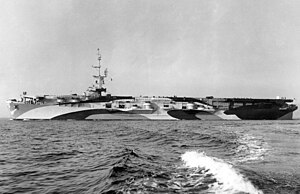USS Commencement Bay
 USS Commencement Bay in early 1945
| |
| History | |
|---|---|
| Name | Commencement Bay |
| Namesake | Commencement Bay in Washington |
| Builder | Todd Pacific Shipyards, Tacoma, Washington |
| Laid down | 23 September 1943 |
| Launched | 9 May 1944 |
| Commissioned | 27 November 1944 |
| Decommissioned | 30 November 1946 |
| Reclassified |
|
| Stricken | 1 April 1971 |
| Fate | Sold for scrap, 25 August 1972 |
| General characteristics | |
| Class and type | Commencement Bay-class escort carrier |
| Displacement | 21,397 long tons (21,740 t) |
| Length | 557 ft 1 in (169.80 m) loa |
| Beam | 75 ft (23 m) |
| Draft | 32 ft (9.8 m) |
| Installed power | |
| Propulsion |
|
| Speed | 19 knots (35 km/h; 22 mph) |
| Complement | 1,066 |
| Armament |
|
| Aircraft carried | 33 |
| Aviation facilities | 2 × aircraft catapults |
USS Commencement Bay (CVE-105) (ex-St. Joseph Bay), the lead ship of her class, was an escort carrier and later helicopter carrier of the United States Navy, used mostly as a training ship.
Design[edit]
In 1941, as United States participation in World War II became increasingly likely, the US Navy embarked on a construction program for escort carriers, which were converted from transport ships of various types. Many of the escort carrier types were converted from C3-type transports, but the Sangamon-class escort carriers were instead rebuilt oil tankers. These proved to be very successful ships, and the Commencement Bay class, authorized for Fiscal Year 1944, were an improved version of the Sangamon design. The new ships were faster, had improved aviation facilities, and had better internal compartmentation.[1]
Commencement Bay was 557 ft 1 in (169.80 m) long overall, with a beam of 75 ft (23 m) at the waterline, which extended to 105 ft 2 in (32.05 m) at maximum. She displaced 21,397 long tons (21,740 t) at full load, of which 12,876 long tons (13,083 t) could be fuel oil (though some of her storage tanks were converted to permanently store seawater for ballast), and at full load she had a draft of 27 ft 11 in (8.51 m). The ship's superstructure consisted of a small island. She had a complement of 1,066 officers and enlisted men.[2]
The ship was powered by two Allis-Chalmers geared steam turbines, each driving one screw propeller, using steam provided by four Combustion Engineering-manufactured water-tube boilers. The propulsion system was rated to produce a total of 16,000 shp (12,000 kW) for a top speed of 19 knots (35 km/h; 22 mph). Given the very large storage capacity for oil, the ships of the Commencement Bay class could steam for some 23,900 nautical miles (44,300 km; 27,500 mi) at a speed of 15 knots (28 km/h; 17 mph).[2]
Her defensive anti-aircraft armament consisted of two 5 in (127 mm) dual-purpose guns in single mounts, thirty-six 40 mm (2 in) Bofors guns, and twenty 20 mm (1 in) Oerlikon light AA cannons. The Bofors guns were placed in three quadruple and twelve twin mounts, while the Oerlikon guns were all mounted individually. She carried 33 planes, which could be launched from two aircraft catapults. Two elevators transferred aircraft from the hangar to the flight deck.[2]
Service history[edit]
Commencement Bay was launched 9 May 1944 by Todd Pacific Shipyards, Tacoma, Washington; sponsored by Mrs. F. Eves; and commissioned 27 November 1944, Captain Roscoe Leroy Bowman in command.
Commencement Bay reported at Seattle 1 February 1945 for duty as a training ship in Puget Sound until 2 October. During this time she trained 545 officers and 5,053 men of precommissioning crews for sister escort carriers, and qualified 249 pilots of eight air groups in carrier takeoffs and landings. She sailed from Bremerton 21 October 1945, and arrived at Pearl Harbor 4 November for training and to conduct carrier qualifications until sailing 27 November for Seattle and Tacoma.
After visits to Los Angeles and San Pedro, she returned to Tacoma 28 January, where she was placed out of commission in reserve 30 November 1946. She was re-classified CVHE-105, 12 June 1955; and AKV-37, 7 May 1959. Commencement Bay was struck from the Navy List on 1 April 1971 before being sold for scrap on 25 August 1972.[3]
References[edit]
Citation[edit]
Bibliography[edit]
This article incorporates text from the public domain Dictionary of American Naval Fighting Ships. The entry can be found here.
- Bauer, K. Jack; Roberts, Stephen S. (1991). Register of Ships of the U.S. Navy, 1775-1990: Major Combatants. Westport, Connecticut: Greenwood Press. ISBN 0-313-26202-0.
- Friedman, Norman (1986). "United States of America". In Gardiner, Robert & Gray, Randal (eds.). Conway's All the World's Fighting Ships 1906–1921. London: Conway Maritime Press. pp. 105–133. ISBN 978-0-85177-245-5.
- "Commencement Bay (CVE-105)". Dictionary of American Naval Fighting Ships. Navy Department, Naval History and Heritage Command. 20 June 2023. Retrieved 27 April 2024.
 This article incorporates text from this source, which is in the public domain.
This article incorporates text from this source, which is in the public domain.
